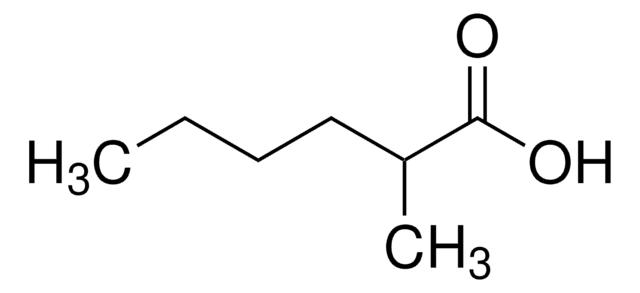75190
Heptanoic acid
≥99.0% (GC)
Synonym(s):
Enanthic acid, Oenanthic acid
About This Item
Recommended Products
vapor density
4.5 (vs air)
Quality Level
vapor pressure
<0.1 mmHg ( 20 °C)
assay
≥99.0% (GC)
form
liquid
expl. lim.
10.1 %
refractive index
n20/D 1.4221 (lit.)
n20/D 1.423
bp
223 °C (lit.)
mp
−10.5 °C (lit.)
density
0.918 g/mL at 25 °C (lit.)
SMILES string
CCCCCCC(O)=O
InChI
1S/C7H14O2/c1-2-3-4-5-6-7(8)9/h2-6H2,1H3,(H,8,9)
InChI key
MNWFXJYAOYHMED-UHFFFAOYSA-N
Looking for similar products? Visit Product Comparison Guide
Application
- For esterification with glycerol to synthesize a triacylglycerol called as triheptanoin or trienanthoin.
- To synthesize 1-hexene via decarbonylation reaction by using platinum nanoparticles supported on carbon.
- To synthesize 7-tridecanone by ketonization in the presence of MnO2/CeO2 or ZrO2 catalysts supported on the surface of alumina.
signalword
Danger
hcodes
Hazard Classifications
Acute Tox. 4 Inhalation - Eye Dam. 1 - Skin Corr. 1B - STOT SE 3
target_organs
Respiratory system
Storage Class
8A - Combustible corrosive hazardous materials
wgk_germany
WGK 1
flash_point_f
235.4 °F - closed cup
flash_point_c
113 °C - closed cup
ppe
Faceshields, Gloves, Goggles, type ABEK (EN14387) respirator filter
Choose from one of the most recent versions:
Already Own This Product?
Find documentation for the products that you have recently purchased in the Document Library.
Customers Also Viewed
Articles
Separation of Propionic acid; Acetic acid; Heptanoic acid; Isobutyric acid; Valeric acid; Isocaproic acid; Butyric acid; Isovaleric acid
Separation of Methyl oleate; Caprylic acid; Heptanoic acid; Methyl decanoate; Methyl dodecanoate; Myristic acid; Methyl palmitate; Methyl palmitoleate; Methyl stearate; Methyl linoleate; Methyl linolenate; Acetic acid; Arachidic acid; Behenic acid; Propionic acid; Isobutyric acid; Valeric acid; Isovaleric acid; Isocaproic acid; Butyric acid
Protocols
In this study, SPME was used for the analysis of free fatty acids in Parmesan cheese using a 65 μm Carbowax/divinylbenzene (DVB) SPME fiber. Headspace extraction of the cheese sample was conducted at 65 °C for 15 minutes and analyzed by GC with FID detection. SPME is ideal for analyzing the volatiles associated with solid food samples. The phase chemistry of the Nukol GC column provides excellent peak shape of acidic compounds.
Our team of scientists has experience in all areas of research including Life Science, Material Science, Chemical Synthesis, Chromatography, Analytical and many others.
Contact Technical Service










